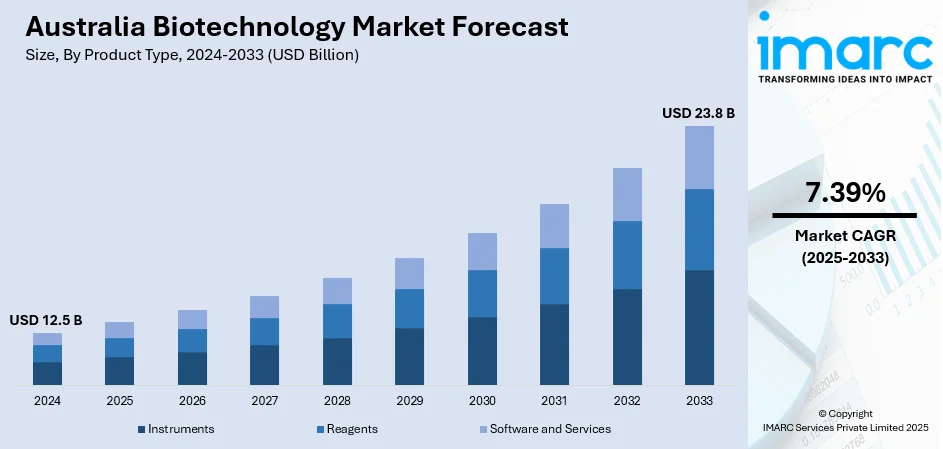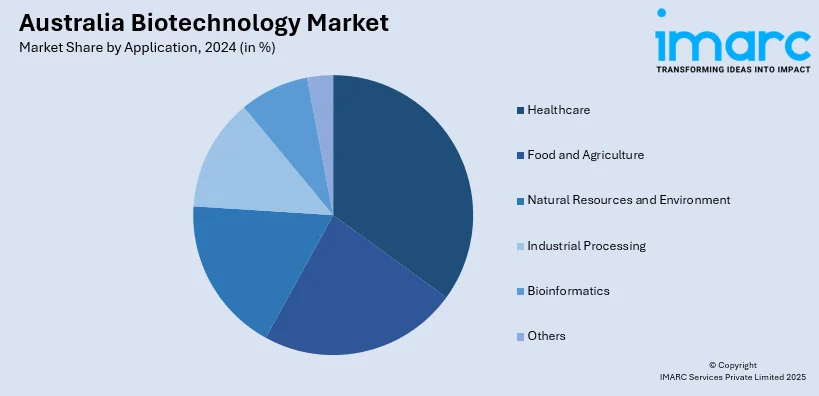
Australia Biotechnology Market Report by Product Type (Instruments, Reagents, Software and Services), Technology (Nanobiotechnology, Tissue Engineering and Regeneration, DNA Sequencing, Cell-Based Assays, Fermentation, PCR Technology, Chromatography, and Others), Application (Healthcare, Food and Agriculture, Natural Resources and Environment, Industrial Processing, Bioinformatics, and Others), and Region 2025-2033
Australia Biotechnology Market Overview:
The Australia biotechnology market size reached USD 12.5 Billion in 2024. Looking forward, IMARC Group expects the market to reach USD 23.8 Billion by 2033, exhibiting a growth rate (CAGR) of 7.39% during 2025-2033. Government support and tax incentives, rising healthcare demand for advanced treatments, increasing collaboration between universities and the private sector, advancements in personalized medicine, availability of a skilled workforce, and the growing prevalence of chronic diseases are some of the factors driving the market growth.
|
Report Attribute
|
Key Statistics
|
|---|---|
|
Base Year
|
2024
|
|
Forecast Years
|
2025-2033
|
|
Historical Years
|
2019-2024
|
| Market Size in 2024 | USD 12.5 Billion |
| Market Forecast in 2033 | USD 23.8 Billion |
| Market Growth Rate 2025-2033 | 7.39% |
Australia Biotechnology Market Trends:
Government Support and Investment Incentives
In Australia, a significant amount of government backing is fostering the market growth. There are several tax incentives offered by the Australian government, such as Research and Development Tax Incentive (RDTI) focused on stimulating investment in biotechnology research. By lowering the financial risks for companies, these programs also spur innovation in medical and agricultural biotechnology. Moreover, coordinated government efforts helps the companies to harness their research and development (R&D) capabilities and partner with research institutions, universities, and companies, which is further propelling the market growth.

To get more information on this market, Request Sample
Growing Healthcare Demand for Advanced Treatments
Australia’s healthcare sector is increasingly relying on biotechnology to address complex medical challenges, driving growth in the biotech market. As the population ages and chronic diseases like cancer, diabetes, and cardiovascular disorders become more prevalent, there is a growing need for advanced, innovative treatments. Biotechnology offers solutions through the development of targeted therapies, regenerative medicine, and personalized treatments, all of which are gaining traction within Australia’s healthcare system. These advances are revolutionizing how diseases are diagnosed and treated, making healthcare more effective and tailored to individual patients.
Collaboration Between Universities, Research Institutes, and the Private Sector
Collaboration is a key driver in Australia's biotechnology market, with universities, research institutions, and private companies working together to accelerate innovation. Australian universities are renowned for their life sciences programs, producing a skilled workforce that is actively involved in cutting-edge biotech research. Government-funded research institutes often collaborate with private biotech firms, facilitating knowledge transfer and commercialization of groundbreaking discoveries. These partnerships enable faster development of biotechnological products, from pharmaceuticals to agricultural solutions. Universities also play a critical role in conducting early-stage research that lays the groundwork for commercial biotech applications.
Australia Biotechnology Market News:
- July 2024: The Walter and Eliza Hall Institute (WEHI) launched the 66ten strategic investment fund to enhance biomedical innovation by supporting early-stage research with commercial potential. With a budget of $66 million over ten years, the fund operates as a pre-seed and seed fund, allowing it to back projects from initial ideation to advanced development stages. The fund is designed to convert groundbreaking scientific discoveries into commercial programs that benefit patients and provide financial returns for investors. The fund has already begun investing in early-stage programs linked to WEHI discoveries, including co-investments with established biotechnology venture capital funds. The ultimate goal is to translate innovative research into practical treatments, diagnostics, and devices that improve patient outcomes.
Australia Biotechnology Market Segmentation:
IMARC Group provides an analysis of the key trends in each segment of the market, along with forecasts at the country level for 2025-2033. Our report has categorized the market based on product type, technology, and application.
Product Type Insights:
- Instruments
- Reagents
- Software and Services
The report has provided a detailed breakup and analysis of the market based on the product type. This includes instruments, reagents, and software and services.
Technology Insights:
- Nanobiotechnology
- Tissue Engineering and Regeneration
- DNA Sequencing
- Cell-Based Assays
- Fermentation
- PCR Technology
- Chromatography
- Others
A detailed breakup and analysis of the market based on the technology have also been provided in the report. This includes nanobiotechnology, tissue engineering and regeneration, DNA sequencing, cell-based assays, fermentation, PCR technology, chromatography, and others.
Application Insights:

- Healthcare
- Food and Agriculture
- Natural Resources and Environment
- Industrial Processing
- Bioinformatics
- Others
The report has provided a detailed breakup and analysis of the market based on the application. This includes healthcare, food and agriculture, natural resources and environment, industrial processing, bioinformatics, and others.
Regional Insights:
- Australia Capital Territory & New South Wales
- Victoria & Tasmania
- Queensland
- Northern Territory & Southern Australia
- Western Australia
The report has also provided a comprehensive analysis of all the major regional markets, which include Australia Capital Territory & New South Wales, Victoria & Tasmania, Queensland, Northern Territory & Southern Australia, and Western Australia.
Competitive Landscape:
The market research report has also provided a comprehensive analysis of the competitive landscape. Competitive analysis such as market structure, key player positioning, top winning strategies, competitive dashboard, and company evaluation quadrant has been covered in the report. Also, detailed profiles of all major companies have been provided.
Australia Biotechnology Market Report Coverage:
| Report Features | Details |
|---|---|
| Base Year of the Analysis | 2024 |
| Historical Period | 2019-2024 |
| Forecast Period | 2025-2033 |
| Units | Billion USD |
| Scope of the Report | Exploration of Historical Trends and Market Outlook, Industry Catalysts and Challenges, Segment-Wise Historical and Future Market Assessment:
|
| Product Types Covered | Instruments, Reagents, Software and Services |
| Technologies Covered | Nanobiotechnology, Tissue Engineering and Regeneration, DNA Sequencing, Cell-Based Assays, Fermentation, PCR Technology, Chromatography, Others |
| Applications Covered | Healthcare, Food and Agriculture, Natural Resources and Environment, Industrial Processing, Bioinformatics, Others |
| Regions Covered | Australia Capital Territory & New South Wales, Victoria & Tasmania, Queensland, Northern Territory & Southern Australia, Western Australia |
| Customization Scope | 10% Free Customization |
| Post-Sale Analyst Support | 10-12 Weeks |
| Delivery Format | PDF and Excel through Email (We can also provide the editable version of the report in PPT/Word format on special request) |
Key Questions Answered in This Report:
- How has the Australia biotechnology market performed so far and how will it perform in the coming years?
- What is the breakup of the Australia biotechnology market on the basis of product type?
- What is the breakup of the Australia biotechnology market on the basis of technology?
- What is the breakup of the Australia biotechnology market on the basis of application?
- What are the various stages in the value chain of the Australia biotechnology market?
- What are the key driving factors and challenges in the Australia biotechnology?
- What is the structure of the Australia biotechnology market and who are the key players?
- What is the degree of competition in the Australia biotechnology market?
Key Benefits for Stakeholders:
- IMARC’s industry report offers a comprehensive quantitative analysis of various market segments, historical and current market trends, market forecasts, and dynamics of the Australia biotechnology market from 2019-2033.
- The research report provides the latest information on the market drivers, challenges, and opportunities in the Australia biotechnology market.
- Porter's five forces analysis assist stakeholders in assessing the impact of new entrants, competitive rivalry, supplier power, buyer power, and the threat of substitution. It helps stakeholders to analyze the level of competition within the Australia biotechnology industry and its attractiveness.
- Competitive landscape allows stakeholders to understand their competitive environment and provides an insight into the current positions of key players in the market.
Need more help?
- Speak to our experienced analysts for insights on the current market scenarios.
- Include additional segments and countries to customize the report as per your requirement.
- Gain an unparalleled competitive advantage in your domain by understanding how to utilize the report and positively impacting your operations and revenue.
- For further assistance, please connect with our analysts.
 Request Customization
Request Customization
 Speak to an Analyst
Speak to an Analyst
 Request Brochure
Request Brochure
 Inquire Before Buying
Inquire Before Buying




.webp)




.webp)












